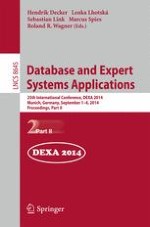This two volume set LNCS 8644 and LNCS 8645 constitutes the refereed proceedings of the 25th International Conference on Database and Expert Systems Applications, DEXA 2014, held in Munich, Germany, September 1-4, 2014. The 37 revised full papers presented together with 46 short papers, and 2 keynote talks, were carefully reviewed and selected from 159 submissions. The papers discuss a range of topics including: data quality; social web; XML keyword search; skyline queries; graph algorithms; information retrieval; XML; security; semantic web; classification and clustering; queries; social computing; similarity search; ranking; data mining; big data; approximations; privacy; data exchange; data integration; web semantics; repositories; partitioning; and business applications.
